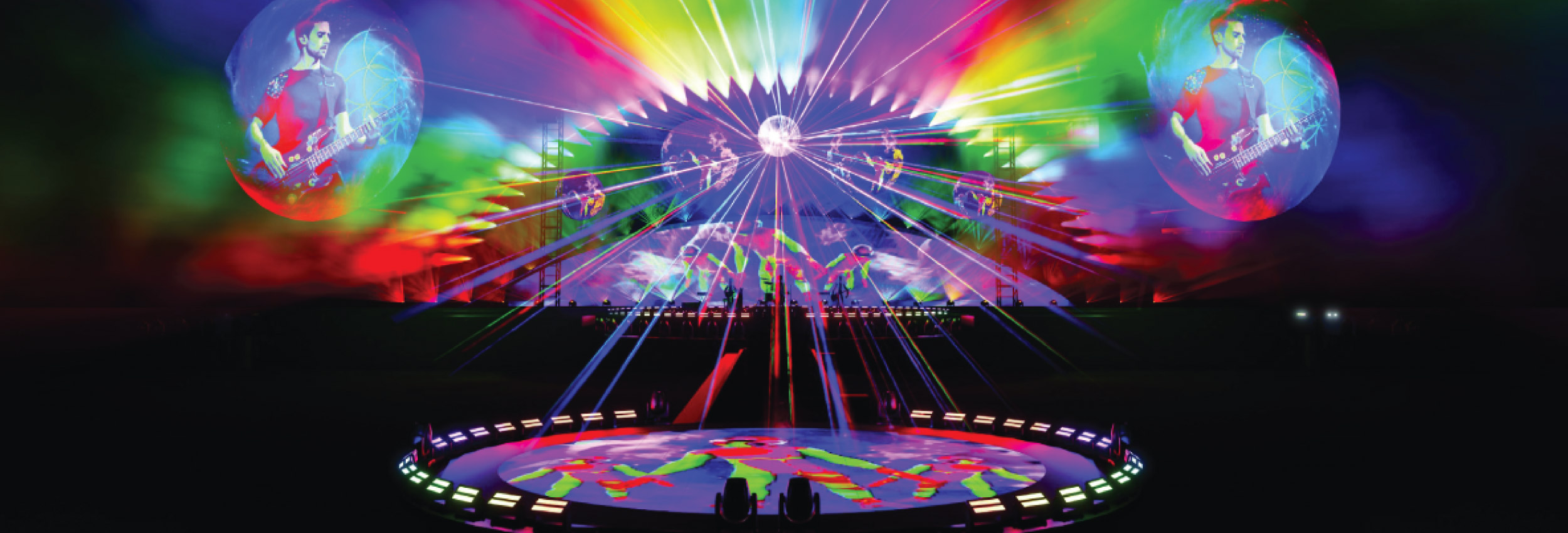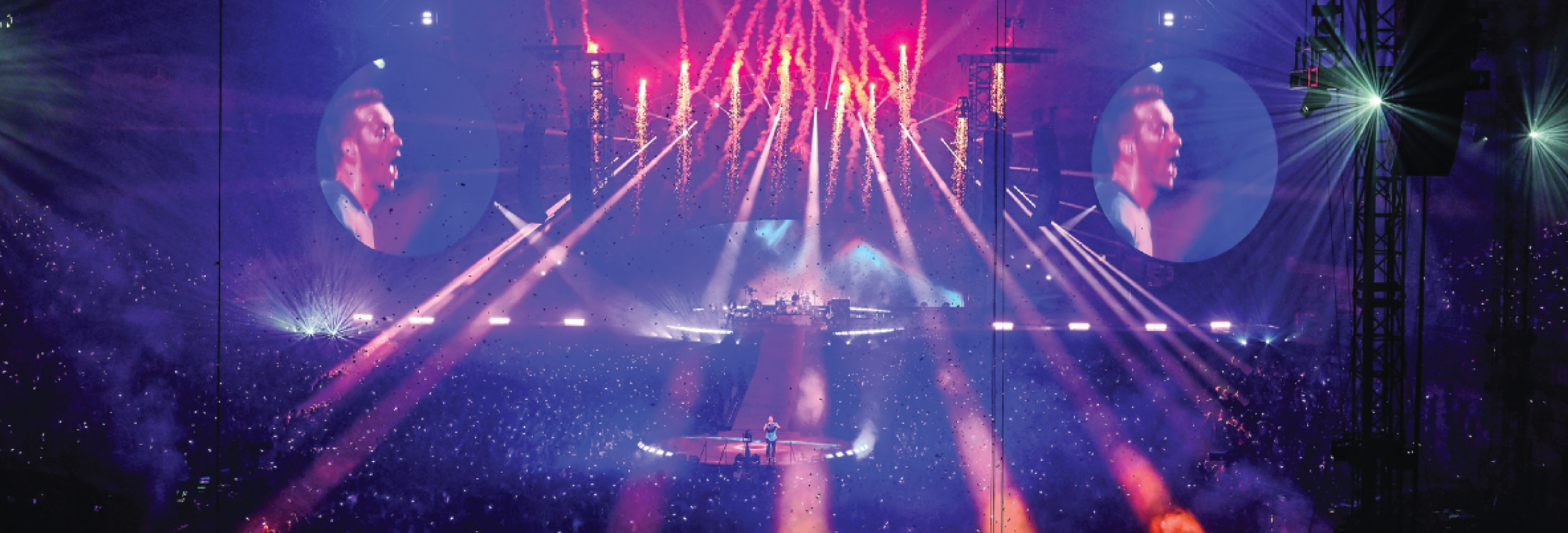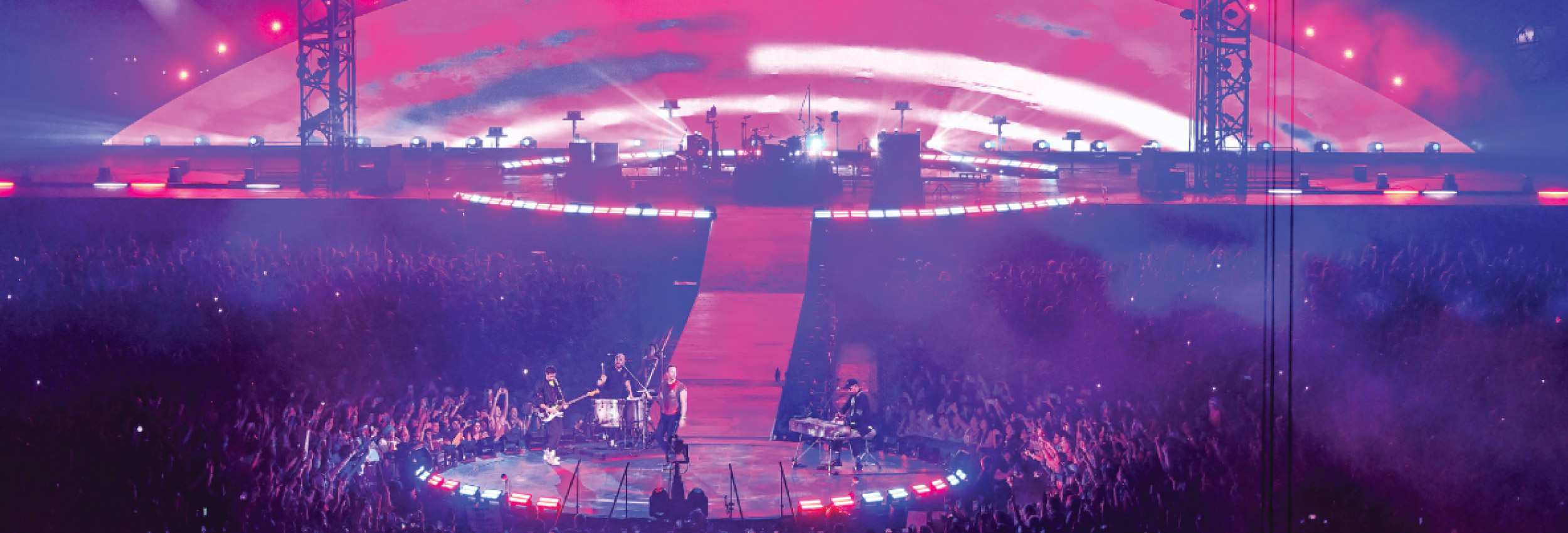The brief was to create a universe of its own,” explains Misty Buckley, production designer and co-creative director [with Phil Harvey], of Coldplay’s Music of the Spheres Tour. “We wanted to create a sustainably minded tour that would transport the audience to a place of pure joy, love, and otherworldliness.”
To create these qualities in a stadium production, Buckley says, “Our starting point was [the ancient Greek philosopher] Pythagoras’ Music of the Spheres philosophy: that the sun, moon, and planets create sounds and harmonies that are not audible to humans but can be heard by our souls. We then explored music in space and went into an amazing creative wormhole of time, space, music, and aliens, which led to the concept of alien music festivals in space, love, people, and togetherness. It was a mad and wonderful creative thread.”
Buckley’s process started with sketches that she “worked up into CAD drawings. We kept going until the geometry worked; then we added alien hieroglyphics and the different languages associated with the [map of the planets featured in] the album’s artwork. We created renders of this concept, which led to the building of a scale model so we could visualize the production design in the context of the stadium.”
The design features a 60m-by-27m stage with a thrust leading to an LED B stage and a separate C stage; all were fabricated by TAIT. The risers, Buckley says, “have been treated with fabric dyed in natural dyes, overstitched and overlaid with screen printing and various different creative processes. We have incorporated alien hieroglyphics and different alien languages into the mark-making and creation of the stage ambience.”
Video
Screens director and video programmer Joshua Koffman says, “Our main IMAG screens are two 14m circles built from Roe [Carbon Series] CB8 with custom pieces to make them round. Upstage is an arched screen [aka the moonrise screen] built from CB8, with custom pieces to make the edge round. It’s just under 40m in width and 6m tall. The side screens primarily show IMAG, but IMAG and content are used on all surfaces interchangeably, often treated as one large canvas, sometimes showing different aspects of the same moment.”
“We make heavy use of Notch treatment on the IMAG throughout,” notes video designer Leo Flint. “There is never a time we put untreated cameras to screen; we are always looking to stylize the imagery Ant [Barrett] is directing, to enhance the world onstage, to immerse the audience and sometimes to have a little fun.” The video system, driven by disguise gx 2c media servers, is provided by PRG.
In keeping with the tour’s title and concept, a key production component is a set of four LED spheres. “We realized early on that trying to ship solid LED spheres was going to be an enormous challenge,” Buckley says. “The sheer volume of truck space and the weight meant it wasn’t looking particularly sustainable.”
Engineering and fabrication of the four spheres was handled by Frederic Opsomer, director at PRG Projects. “It was not very clear at the start of the tour how and from what the spheres would hang,” he says. “So it was important to make them as light as possible. Truck space—only one truck for four spheres—and installation time were obviously of equal importance.” The team at PRG Projects experimented with materials, deciding upon sailcloth. “On the north pole side,” he continues, “we installed a unit that contains all the power and data management, and acts as a lifting device. Engineering on the properties of the fabric, sew thread, internal air pressure, and central unit was crucial as the spheres obviously have to keep their shape, even under windy conditions.” Two spheres are 10' in diameter, weighing 900lb, and two spheres are 15' in diameter, weighing 1,200lb. “The LED is a custom made—PRG designed—LED strip; the strip pitch is 25mm,” Opsomer adds. “The center-to-center distance between the strip varies according to its position on the sphere, which is between 20mm and 30mm.”
For IMAG, says Barrett, “We are using ten Sony HDC-4300 studio cameras. Five of these are mounted on Blackcam rail systems and are remotely operated. These allow for a huge range of dynamic movement, including tracking and lifting in addition to the usual pan/tilt/zoom. We have a number of remote heads as well—Panasonic AW-UE150s—and some Blackmagic Micro Studio 4K mini cameras.”
Read the rest of the article on LSA’s print/digital edition.
Written by: Sharon Stancavage
Photos by: Steve Jennings











